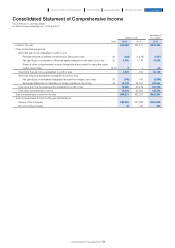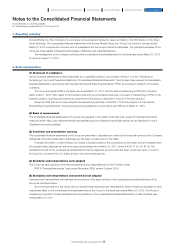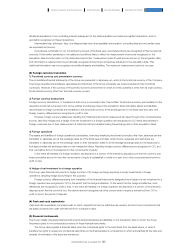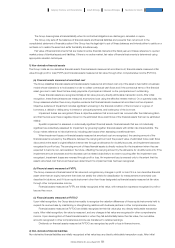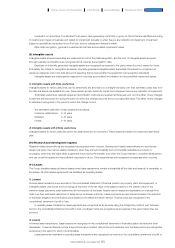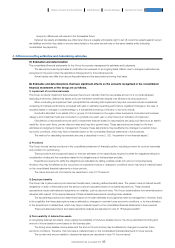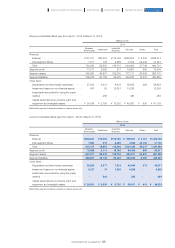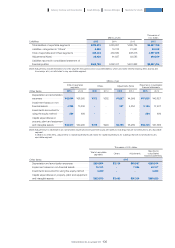Konica Minolta 2015 Annual Report Download - page 93
Download and view the complete annual report
Please find page 93 of the 2015 Konica Minolta annual report below. You can navigate through the pages in the report by either clicking on the pages listed below, or by using the keyword search tool below to find specific information within the annual report.
recognition, these liabilities are measured at amortized cost using the effective interest method.
3) Derivative financial instruments and hedge accounting
The Group holds derivative financial instruments to hedge exchange rate risk exposures and interest rate risk exposures. The Group
limits its transactions in these instruments to those actually required for hedging purposes and not for speculation purposes.
Derivative financial instruments are initially recognized at fair value, with any attributable transaction costs recognized in profit or
loss as they occur. After initial recognition, fair value is remeasured, and the following accounting policies are applied for changes
depending on whether derivative financial instruments satisfy the conditions for hedge accounting. The Group applies hedge
accounting on those derivative financial instruments that satisfy the conditions for hedge accounting.
(a) Derivative financial instruments that do not satisfy the conditions for hedge accounting
Changes in fair value are recognized in profit or loss.
(b) Derivative financial instruments that satisfy the conditions for hedge accounting
On initial designation of the derivative as the hedging instrument, the Group formally documents the relationship between the
hedging instrument and the hedged item, and the objectives and strategies of risk management for undertaking the hedge, as
well as the method for assessing the effectiveness of the hedge. At the inception of the hedge and on an ongoing basis
thereafter, hedges are assessed as to whether they are highly effective in offsetting changes in cash flows of the hedging
instrument and the cash flows of the hedged item.
The effective portion of changes in the fair value of the hedging instrument is recognized in OCI, while the ineffective
portion is recognized immediately in profit or loss.
The cumulative profits or losses recognized through OCI are reclassified from OCI to profit or loss in the consolidated
statement of comprehensive income in the same period during which the hedged item affects profit and loss.
If the hedging instrument no longer meets the criteria for hedge accounting, expires or is sold, terminated or exercised, or
the designation is revoked, or if the forecast transaction is no longer expected to occur, then hedge accounting is discontinued
prospectively.
(6) Inventories
The cost of inventories includes purchase costs, processing costs and all other costs incurred to bring inventories to their present
location and condition.
Inventories are measured at the lower of cost or net realizable value. The weighted average method is used to calculate cost. If
net realizable value is less than the cost, that difference is accounted for as a write off and recognized as an expense. Net realizable
value represents the estimated selling price in the ordinary course of business, less all estimated costs of completion and estimated
costs necessary to make the sale.
(7) Property, plant and equipment
The cost of property, plant and equipment includes any costs directly attributable to the acquisition of the asset and dismantlement,
removal and restoration costs, as well as borrowing costs that satisfy the conditions for capitalization.
Property, plant and equipment is measured at cost less accumulated depreciation and accumulated impairment losses.
Except for land (with certain exceptions) and construction in progress, the cost less residual value of each asset is depreciated
on a straight-line basis over its estimated useful life.
If the estimated useful life, residual value or depreciation method are reviewed or revised at the fiscal year-end date, the effect
of any changes in estimate are accounted for during the period in which the change occurred and on a prospective basis. The effect
of any changes in estimates is recognized in the period in which the change occurs.
The estimated useful lives of major assets are as follows:
Buildings and structures: 3–50 years
Machinery and vehicles: 2–15 years
Tools and equipment: 2–20 years
Lease assets: 3–5 years
(8) Goodwill
Goodwill indicates the amount by which the cost of the NCI acquired in a business combination exceeds the net recognized amount
of identifiable assets acquired and liabilities assumed at the time of acquisition. Details on the measurement of goodwill at initial
recognition are described in (2) Business Combinations.
92
KONICA MINOLTA, INC. Annual Report 2015
Foundation for GrowthBusiness StrategiesGrowth StrategyCompany Overview and Characteristics Financial Report




